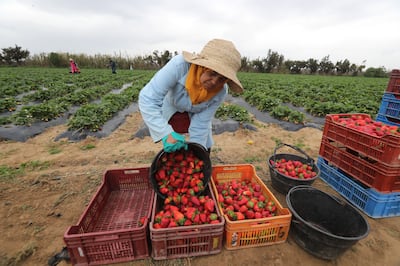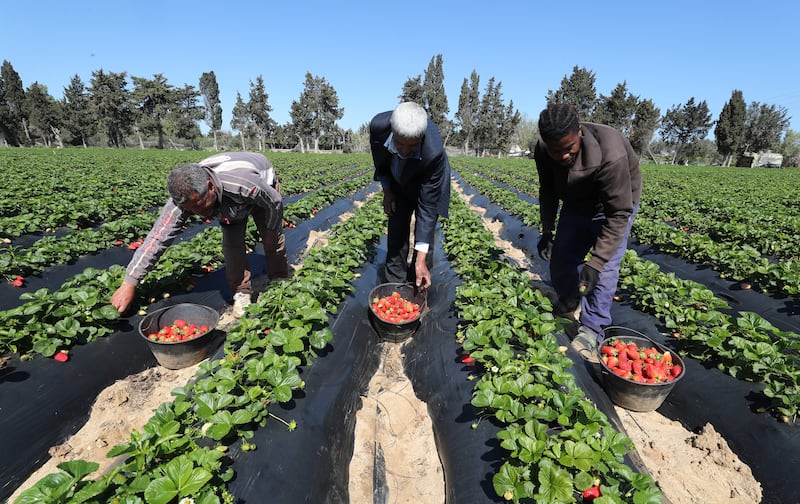Since 2019, Tunisia has been struggling with a drought that has left most of its dams and reservoirs almost empty and, with rising temperatures and longer summers, is placing more pressure on already depleted groundwater sources.
On March 31, the Ministry of Agriculture announced the introduction of a quota system for piped potable water, which meant that authorities would begin cutting the supply to households every night.
But experts and observers believe that the government’s focus on rationing water is pointless because most of the country’s supply goes to one major sector — agriculture.
The agricultural sector consumes more than 80 per cent of Tunisia's water reserves, according to the United Nations Food and Agriculture Organisation.
Shift to irrigation-based agriculture
Since the early 1970s, the Tunisian state chose to focus its agricultural sector on olive oil and citrus plantations, as well as fruit such as dates and strawberries, all of which require large amounts of water.
These products have a greater chance of being exported, unlike basic items such as grains and legumes that Tunisian farmers focused on previously.
The government's goal was to modernise the country's agriculture, increase added value, create jobs, and bring in as much foreign currency as possible.

Authorities also began gradually to abandon support policies for small farmers. Instead, they sought to create favourable conditions for foreign investors and wholesale producers whose focus was on profit rather than sustainable production for the local market, which did not benefit them as much.
As a result, agricultural water consumption in Tunisia has increased dramatically over the past 50 years. The area under irrigation jumped from 50,000 hectares in the late 1960s to half a million hectares today, according to figures provided by the Ministry of Agriculture.
The drought that Tunisia is experiencing is not the first in its history, but comes at a time when the country's water resources are increasingly used for export-focused commercial agriculture in what experts see as a systematic exhaustion of water reserves needed for human consumption.
For instance, citrus and date cultivation alone accounted for more than half of the country’s water consumption in 2021 — about 320 million cubic metres a year for citrus crops and 300 million for dates, according to the Ministry of Agriculture’s annual water report. In comparison, Tunisian households consumed about 500 million cubic metres that year.
Farmers reap problems
Farmers find themselves obliged to shift to these and other heavily-irrigated crops, such as watermelon and lettuce, because of the demand from export markets.
Tayssir Garbouj, 29, has been cultivating strawberries and vegetables for 10 years, and his father has been doing it for 20 years before him.
Mr Garbouj says his main observation over this time is that strawberries cost them a lot of water resources and money as Tunisia becomes increasingly dependent on seed imports year after year.
“It needs excessive water; we might get lucky if it rains but most of the time we rely on available water sources,” he told The National.
Farmers need to water their strawberry fields daily for nine consecutive months to be able to reap a harvest.
With water becoming increasingly scarce, Mr Garbouj says he does not see a future for agriculture in Tunisia.
He also cited the problem of obtaining seeds.
“There is a huge difference between our government’s policy and that of our neighbour Egypt, for example," he said.
"We keep relying on imports for seeds and that keeps us dependent. While they [Egypt] evolve and develop their own seeds, we keep going backwards through resorting to the easy solution, which is imports.”
Worn-out water channels
Tunisia lacks resources for the maintenance of the National Water Exploitation and Distribution Company’s pipelines, which are old and rusty, because of the financial crisis the country has faced in recent years.
According to the agriculture ministry report, Tunisia lost about 268 million cubic metres of water in 2021 caused by poor pipelines, which represents 32.5 per cent of the amount distributed that year.
Due to increasing austerity policies, the ministry reduced the budget allocated for water sources, from 672 million dinars ($221.3 million) in 2020 to 470 million dinars in 2021.
The warming factor
According to experts, the drought that Tunisia is experiencing cannot be linked only to low rainfall for an extended period, which occurs once every 10 or 20 years.
It is rather a direct effect of the increase in temperatures in the Mediterranean Basin countries.
Temperatures in the region have increased at a rate 20 per cent faster than the rest of the world.
Consequently, rainfall will decrease and reliance on groundwater tables will be increase, leading to their depletion.







